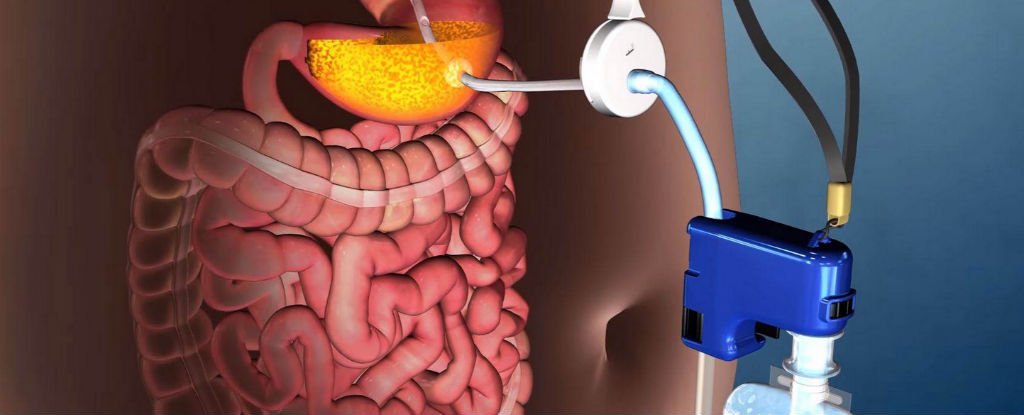Calories in the toilet - not your body.
The US Food and Drug Administration (FDA) just approved a device that drains a portion of your stomach contents directly into the toilet after every meal.
It sounds gross (and it is), but the device has been designed as a weight-loss aid, by removing a third of what you eat before your body's had time to digest and absorb it.
With FDA approval, the innocuously named AspireAssist will now be made available to select patients who are struggling with obesity. It’s being marketed as a cheaper, easier, and less invasive treatment than bariatric surgery, which, in the simplest terms, is like putting a surgical band around your stomach.
"The AspireAssist approach helps provide effective control of calorie absorption, which is a key principle of weight management therapy," said William Maisel, deputy director for science and chief scientist at the FDA's Centre for Devices and Radiological Health.
"Patients need to be regularly monitored by their health-care provider and should follow a lifestyle program to help them develop healthier eating habits and reduce their calorie intake."
Designed by researchers at Aspire Bariatrics in Pennsylvania, the portable device works by hooking up to a tube in the stomach, which is surgically inserted into the body during a 15-minute procedure. A little plug called a skin-port sits on the skin - almost like a second belly button - to give access to the stomach tube.
You basically turn it on, and watch all the glorious things you ate about 20 to 30 minutes ago funnel into the toilet in front of you. The tube sits in the upper portion of the stomach, which means it can only siphon off the top 30 percent of what’s sitting in there.
After about 5 or 10 minutes of draining, you flush the entire system and your stomach out with fresh water:
This week's FDA approval was based on a recent clinical trial of 171 obese patients, which found that the device can remove around 30 percent of the total calories consumed.
There were 111 patients in the AspireAssist group, and 60 controls. Both groups received lifestyle therapy, which means being teamed up with counsellors who helped them maintain healthy diets and exercise regimes.
After one year, the control group receiving lifestyle therapy alone lost 3.6 percent of their total body weight, while the AspireAssist group lost an average of 12.1 percent.
Okay, let’s be real here for a minute, because the whole thing is a little bit shocking, and a little bit nightmarish, and it says so much about the state of humanity now and in the coming decades, I’m surprised Futurama didn’t come up with it first.
And it's easy to laugh, and tell those living with obesity to just exercise more and eat less, but with the number of obese people in the world now outnumbering underweight people, and the obese population having risen from 105 million in 1975 to 641 million today, obesity is pretty much everyone’s problem now. If we have to think out of the box, and erm, through the tube and into the toilet, science is there for us.
No one’s quite sure why we’re seeing such an incredible surge in people who are able to put on a huge amount of weight an then struggle to lose it, but it could be anything from how food has changed in recent decades, air pollution, an individual’s genetic make-up, the fact that we sit all day long, or all of the above.
There are some pretty massive caveats when it comes to AspireAssist - you have to chew the hell out of your food, because the device can only suck up tiny pieces, and patients have experienced symptoms ranging from sore throats to bleeding and pneumonia, and irritations around the valve on the outside of the body, Robert Ferris from CNBC reports.
Also no, the device is not a bulimia assist. "The AspireAssist device should not be used on patients with eating disorders, and it is not intended to be used for short durations in those who are moderately overweight," the FDA said in a statement.
The cost alone will likely deter all but the most in-need patients. According to Katherine Ellen Foley at Quartz, not including the cost of the procedure to insert the device, "the total costs for patients - including additional lifestyle counselling - may be anywhere from US$8,000 to $13,000".
For some patients though, the cost will probably be worth it. "This is it for me. I've been jumping up and down in weight for 30 years," one of the trial patients, Mikael Cederhag, who's lost 30 kg (64 pounds) so far, told ABC News. "Finally, this is a solution that allows me to get my weight down and stay that way."
Thought I'd seen everything Yuk !
Graham


4 comments:
Sounds kind of creepy to me. I'd rather just eat less to begin with.
Oh my goodness . . . I don't know what to say.
this is new to me and the concept somewhat interesting and a little gross. i eat less, eat right and i never loose any weight. i think what i need is exercise and that is not something i can do!!!
Or, how about something much more simple. Stop putting so much rubbish in their mouths.
Post a Comment